in defence of beauty in art
- Written by Robert Wellington, Senior Lecturer, Art History and Visual Culture, Australian National University
Art critics and historians have a difficult time dealing with beauty. We are trained from early on that the analysis of a work of art relies on proof, those things that we can point to as evidence. The problem with beauty is that it’s almost impossible to describe. To describe the beauty of an object is like trying to explain why something’s funny — when it’s put into words, the moment is lost.
Works of art need not be beautiful for us to consider them important. We need only think of Marcel Duchamp’s “readymade” urinal that he flipped on its side, signed with a false name, and submitted to the exhibition of the newly founded Society of Independent Artists in New York in 1917. We’d have a hard time considering this object beautiful, but it is widely accepted to be one of most important works of Western art from the last century.
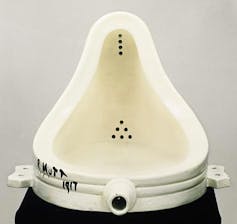 Marcel Duchamp, Fountain, 1917, replica 1964.
Collection: Tate. http://www.tate.org.uk/art/artworks/duchamp-fountain-t07573
Marcel Duchamp, Fountain, 1917, replica 1964.
Collection: Tate. http://www.tate.org.uk/art/artworks/duchamp-fountain-t07573
To call something beautiful is not a critical assertion, so it’s deemed of little value to an argument that attempts to understand the morals, politics, and ideals of human cultures past and present. To call something beautiful is not the same as calling it an important work of art. As a philosopher might say, beauty is not a necessary condition of the art object.
And yet, it is often the beauty we perceive in works of art from the past or from another culture that makes them so compelling. When we recognise the beauty of an object made or selected by another person we understand that maker/selector as a feeling subject who shared with us an ineffable aesthetic experience. When we find something beautiful we become aware of our mutual humanity.
Take, for example, the extraordinary painting Yam awely by Emily Kam Kngwarry in our national collection. Like so many Indigenous Australians, Kngwarry has evoked her deep spiritual and cultural connection to the lands that we share through some of the most intensely beautiful objects made by human hands.
 Emily Kam Kngwarray, Anmatyerr people.
Yam awely 1995
synthetic polymer paint on canvas
150 x 491 cm
National Gallery of Australia, Canberra Gift of the Delmore Collection, Donald and Janet Holt 1995 © Emily Kam Kngwarray. Licensed by Viscopy
Emily Kam Kngwarray, Anmatyerr people.
Yam awely 1995
synthetic polymer paint on canvas
150 x 491 cm
National Gallery of Australia, Canberra Gift of the Delmore Collection, Donald and Janet Holt 1995 © Emily Kam Kngwarray. Licensed by Viscopy
In her work we can trace the lines of the brush, the wet-on-wet blend of colours intuitively selected, the place of the artist’s body as she moved about the canvas to complete her design. We can uncover her choices—the mix of predetermination and instinct of a maker in the flow of creation.
It is not our cultural differences that strike me when I look at this painting. I know that a complex set of ideas, stories, and experiences have informed its maker. But what captures me is beyond reason. It cannot be put into words. My felt response to this work does not answer questions of particular cultures or histories. It is more universal than that. I am aware of a beautiful object offered up by its maker, who surely felt the beauty of her creation just as I do.
Let me be clear. I am not saying that works of art ought to be beautiful. What I want to defend is our felt experience of beauty as way of knowing and navigating the world around us.
The aesthete as radical
The aesthete — a much maligned figure of late-19th and early-20th century provides a fascinating insight on this topic. Aesthetes have had a bad rap. To call someone an aesthete is almost an insult. It suggests that they are frivolous, vain, privileged, and affected. But I would like to reposition aesthetes as radical, transgressive figures, who challenged the very foundations of the conservative culture in which they lived, though an all-consuming love of beautiful things.
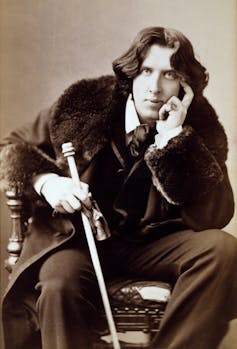 Oscar Wilde, c. 1882.
Napoleon Sarony, Library of Congress.
Oscar Wilde, c. 1882.
Napoleon Sarony, Library of Congress.
Oscar Wilde was, perhaps, the consummate Aesthete - famed as much for his wit as for his foppish dress and his love of peacock feathers, sun flowers and objets d’art. His often-quoted comment “I find it harder and harder every day to live up to my blue china” has been noted as a perfect summary of the aesthete’s vacuous nature.
For Wilde and his followers, the work of art — whether it be a poem, a book, a play, a piece of music, a painting, a dinner plate, or a carpet — should only be judged on the grounds of beauty. They considered it an utterly vulgar idea that art should serve any other purpose.
Over time, the term “aesthete” began to take on new meanings as a euphemism for the effete Oxford intellectual. Men like Wilde were an open threat to acceptable gender norms—the pursuit of beauty, both in the adoration of beautiful things, and in the pursuit of personal appearances, was deemed unmanly. It had long been held that men and women approached the world differently. Men were rational and intellectual; women emotional and irrational.
These unfortunate stereotypes are very familiar to us, and they play both ways. When a woman is confident and intellectual she is sometimes deemed unfeminine. When she is emotional and empathic, she is at risk of being called hysterical. Likewise, a man who works in the beauty industry — a make-up artist, fashion designer, hairdresser, or interior designer — might be mocked for being effete and superficial. We only need to look to the tasteless comments made about Prime Minister Julia Gillard and her partner Tim Mathieson to see evidence of that today.
By the 1880s, many caricatures were published of a flamboyant Wilde as a cultivated aesthete. One cartoon from the Washington Post lampooned the aesthete with a reference to Charles Darwin’s controversial theory of evolution. How far is the aesthete from the ape, it asked. Here the pun relies on a comparison made between the irrational ape — Darwin’s original human — and Wilde the frivolous aesthete.
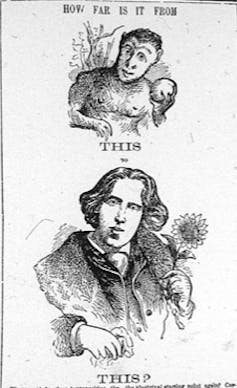 Washington Post, 22 January 1882
The aesthete was a dangerous combination of male privilege, class privilege, and female sensibility. The queerness of aesthetes like Wilde was dangerously transgressive, and the pursuit of beauty provided a zone in which to challenge the heteronormative foundations of conservative society, just as Darwin’s radical theories had challenged Christian beliefs of the origins of humankind.
Wilde’s legacy was continued by a new generation of young aristocrats at a time of cultural crises between the two World Wars. The Bright Young Things, as they were called, were the last bloom of a dying plant — the last generation of British aristocrats to lead a life of unfettered leisure before so many were cut down in their prime by the war that permanently altered the economic structure of Britain.
Stephen Tennant was the brightest of the Bright Young Things. He was the youngest son of a Scottish peer, a delicate and sickly child whose recurrent bouts of lung disease lent him a thin, delicate, consumptive and romantic appearance.
Washington Post, 22 January 1882
The aesthete was a dangerous combination of male privilege, class privilege, and female sensibility. The queerness of aesthetes like Wilde was dangerously transgressive, and the pursuit of beauty provided a zone in which to challenge the heteronormative foundations of conservative society, just as Darwin’s radical theories had challenged Christian beliefs of the origins of humankind.
Wilde’s legacy was continued by a new generation of young aristocrats at a time of cultural crises between the two World Wars. The Bright Young Things, as they were called, were the last bloom of a dying plant — the last generation of British aristocrats to lead a life of unfettered leisure before so many were cut down in their prime by the war that permanently altered the economic structure of Britain.
Stephen Tennant was the brightest of the Bright Young Things. He was the youngest son of a Scottish peer, a delicate and sickly child whose recurrent bouts of lung disease lent him a thin, delicate, consumptive and romantic appearance.
 Stephen Tennant circa 1920-25.
Foulsham Banfield/Wikimedia Commons
Stephen was immortalised as the character of Lord Sebastian Flyte in Evelyn Waugh’s masterpiece, Brideshead Revisited. Waugh’s character of the frivolous Oxford Aesthete who carries around his teddy bear, Aloysius, and dotes on his Nanny, borrows these characteristics from Stephen — who kept a plush monkey as a constant companion right up until his death.
Waugh’s book is a powerful meditation on art, beauty and faith. The narrator, Charles Ryder, is thought to have been loosely based on Tennant’s close friend, the painter/illustrator Rex Whistler, the aesthete-artist who tragically died on his first day of engagement in the Second World War.
Through the character of Charles, Waugh grapples with the dilemma of beauty vs erudition. Visiting Brideshead, the magnificent country estate of Sebastian’s family, Charles is keen to learn its history and to train his eye. He asks his host, “Is the dome by Inigo Jones, too? It looks later.” Sebastian replies: “Oh, Charles, don’t be such a tourist. What does it matter when it was built, if it’s pretty?” Sebastian gives the aesthete’s response, that a work of art or architecture should be judged on aesthetic merit alone.
Stephen Tennant circa 1920-25.
Foulsham Banfield/Wikimedia Commons
Stephen was immortalised as the character of Lord Sebastian Flyte in Evelyn Waugh’s masterpiece, Brideshead Revisited. Waugh’s character of the frivolous Oxford Aesthete who carries around his teddy bear, Aloysius, and dotes on his Nanny, borrows these characteristics from Stephen — who kept a plush monkey as a constant companion right up until his death.
Waugh’s book is a powerful meditation on art, beauty and faith. The narrator, Charles Ryder, is thought to have been loosely based on Tennant’s close friend, the painter/illustrator Rex Whistler, the aesthete-artist who tragically died on his first day of engagement in the Second World War.
Through the character of Charles, Waugh grapples with the dilemma of beauty vs erudition. Visiting Brideshead, the magnificent country estate of Sebastian’s family, Charles is keen to learn its history and to train his eye. He asks his host, “Is the dome by Inigo Jones, too? It looks later.” Sebastian replies: “Oh, Charles, don’t be such a tourist. What does it matter when it was built, if it’s pretty?” Sebastian gives the aesthete’s response, that a work of art or architecture should be judged on aesthetic merit alone.
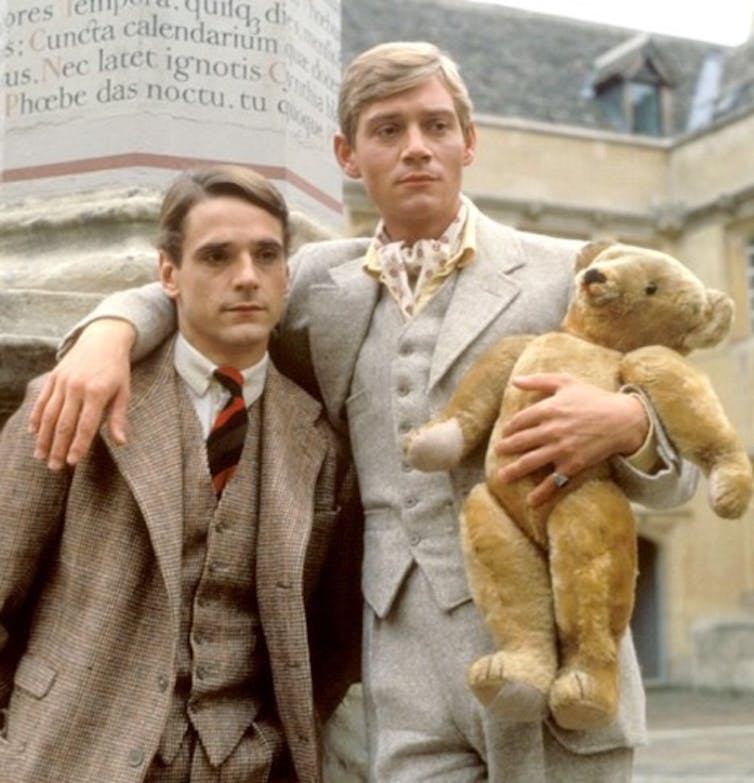 Charles Ryder (Jeremy Irons) and Lord Sebastian Flyte (Anthony Andrews), a still from the 1981 Granda Television adaptation of Evelyn Waugh, Brideshead Revisited.
Granada
I’m not suggesting that we should all drop what we’re doing and quit our jobs to pursue an uncompromising pursuit of beauty. But I do think we can learn something from the aesthete’s approach to life.
Aesthetes like Wilde and Tennant, cushioned by their privilege, transgressed the accepted norms of their gender to pursue a life not governed by reason but by feeling. This is a radical challenge to our logocentric society; a challenge to a world that often privileges a rational (masculine) perspective that fails to account for our deeply felt experience of the world around us.
How, then, to judge works of art?
How, then, should the art critic proceed today when beauty counts for so little in the judgement of works of art?
The unsettling times in which we live lead us to question the ethics of aesthetics. What happens when we find an object beautiful that was produced by a person or in a culture that we judge to be immoral or unjust?
I often encounter this problem with works of art produced for the French court in the 17th and 18th century – the period I study.
Last year, when I took a group through the exhibition Versailles: Treasures from the Palace at the National Gallery of Australia, one student was particularly repulsed by Sèvres porcelain made for members of the Court of French king Louis XV. For her, it was impossible to like those dishes and bowls, because she felt they represented the extraordinary inequity of Old Regime France – these exquisitely refined objects were produced at the expense of the suffering poor, she thought.
I suppose that might be true, but I can’t help it – I find this porcelain irresistibly beautiful.
The vibrant bleu-celeste glaze, the playful rhythm of ribbons and garlands of flowers, those delicate renderings painted by hand with the tiniest of brushes. It is the beauty of such objects that compels me to learn more about them.
Charles Ryder (Jeremy Irons) and Lord Sebastian Flyte (Anthony Andrews), a still from the 1981 Granda Television adaptation of Evelyn Waugh, Brideshead Revisited.
Granada
I’m not suggesting that we should all drop what we’re doing and quit our jobs to pursue an uncompromising pursuit of beauty. But I do think we can learn something from the aesthete’s approach to life.
Aesthetes like Wilde and Tennant, cushioned by their privilege, transgressed the accepted norms of their gender to pursue a life not governed by reason but by feeling. This is a radical challenge to our logocentric society; a challenge to a world that often privileges a rational (masculine) perspective that fails to account for our deeply felt experience of the world around us.
How, then, to judge works of art?
How, then, should the art critic proceed today when beauty counts for so little in the judgement of works of art?
The unsettling times in which we live lead us to question the ethics of aesthetics. What happens when we find an object beautiful that was produced by a person or in a culture that we judge to be immoral or unjust?
I often encounter this problem with works of art produced for the French court in the 17th and 18th century – the period I study.
Last year, when I took a group through the exhibition Versailles: Treasures from the Palace at the National Gallery of Australia, one student was particularly repulsed by Sèvres porcelain made for members of the Court of French king Louis XV. For her, it was impossible to like those dishes and bowls, because she felt they represented the extraordinary inequity of Old Regime France – these exquisitely refined objects were produced at the expense of the suffering poor, she thought.
I suppose that might be true, but I can’t help it – I find this porcelain irresistibly beautiful.
The vibrant bleu-celeste glaze, the playful rhythm of ribbons and garlands of flowers, those delicate renderings painted by hand with the tiniest of brushes. It is the beauty of such objects that compels me to learn more about them.
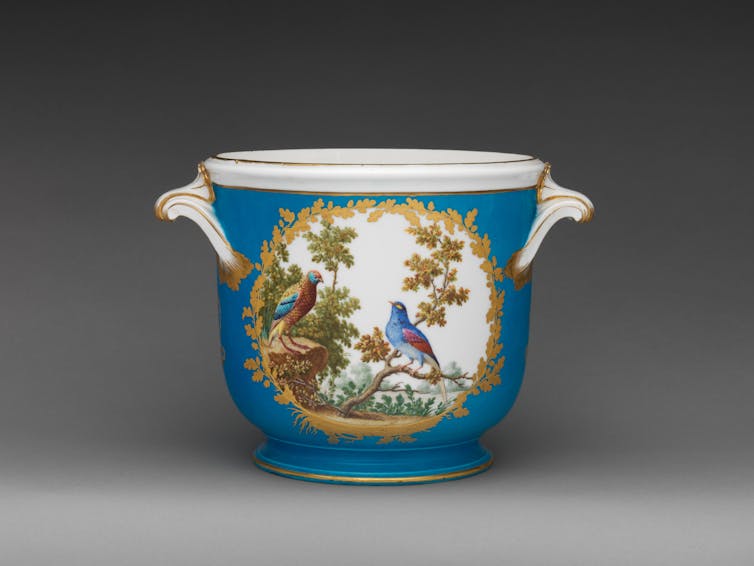 A Sevres wine-bottle cooler (part of a service), 1771–72.
Wikimedia Commons
When it was first made, Sèvres porcelain demonstrated the union of science and art. We are meant to marvel at the chemistry and artistry required to transform minerals, metal and clay into a sparkling profusion of decoration. This porcelain was the material embodiment of France as an advanced and flourishing nation.
You might well argue that the politics of 18th-century porcelain is bad. But our instinctual perception of beauty precedes the reasoned judgement of art.
The artists and makers at the Sèvres factory were responding to the human capacity to perceive beauty. These objects were designed to engage our aesthetic sensibilities.
Works of art don’t have to be beautiful, but we must acknowledge that aesthetic judgement plays a large part in the reception of art. Beauty might not be an objective quality in the work of art, nor is it a rational way for us to argue for the cultural importance of an object. It’s not something we can teach, and perhaps it’s not something you can learn.
But when it comes down to it, our ability to perceive beauty is often what makes a work of art compelling. It is a feeling that reveals a pure moment of humanity that we share with the maker, transcending time and place.
A Sevres wine-bottle cooler (part of a service), 1771–72.
Wikimedia Commons
When it was first made, Sèvres porcelain demonstrated the union of science and art. We are meant to marvel at the chemistry and artistry required to transform minerals, metal and clay into a sparkling profusion of decoration. This porcelain was the material embodiment of France as an advanced and flourishing nation.
You might well argue that the politics of 18th-century porcelain is bad. But our instinctual perception of beauty precedes the reasoned judgement of art.
The artists and makers at the Sèvres factory were responding to the human capacity to perceive beauty. These objects were designed to engage our aesthetic sensibilities.
Works of art don’t have to be beautiful, but we must acknowledge that aesthetic judgement plays a large part in the reception of art. Beauty might not be an objective quality in the work of art, nor is it a rational way for us to argue for the cultural importance of an object. It’s not something we can teach, and perhaps it’s not something you can learn.
But when it comes down to it, our ability to perceive beauty is often what makes a work of art compelling. It is a feeling that reveals a pure moment of humanity that we share with the maker, transcending time and place.
Authors: Robert Wellington, Senior Lecturer, Art History and Visual Culture, Australian National University
Read more http://theconversation.com/friday-essay-in-defence-of-beauty-in-art-89921





